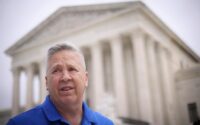‘Do it where you live’
Louisiana environmentalists and locals are growing increasingly concerned about certain carbon capture projects supported by President Biden’s climate initiative, as nearby Black communities grapple with already elevated cancer risks from existing chemical plants.
Donaldsonville, Louisiana, is home to several petrochemical plants and refineries, which emits massive amounts of carbon dioxide into the environment each year.
The White House and the oil industry are seeking to fast-track a project to store the emissions underground to delay climate warming with their carbon capture and storage initiative.
The Environmental Protection Agency is reportedly prepared to grant their request, but environmental justice activists – once considered Biden’s key allies – are pushing back, according to a Washington Post report.
“Don’t do it in my neighborhood. Do it where you live,” Ashley Gaignard, who voted for Biden in 2020 and started a group to preserve rural land locally, said at an EPA-hosted meeting last week in Baton Rouge.

“Right about now it’s politics over people. And I don’t think they give a damn about people,” she reportedly said.
Donaldsonville environmental activists like Gaignard say they oppose such carbon capture projects largely because of the communities’ already elevated cancer rates and the existing petrochemical plants, which are in close proximity to Black churches and schools.
The industrial corridor near New Orleans, which is home to the world’s largest ammonia plant and is the state’s largest greenhouse gas emitter, is commonly called “Cancer Alley” because of the troubling cancer rates locally.

The Washington Post report quoted Beverly Wright, the executive director of the Deep South Center for Environmental Justice and member of the White House Environmental Justice Advisory Council, who said she fears the carbon capture effort could be “the worst of anything we’ve been exposed to, because of all the uncertainty.”
“In the real world, this is an experiment,” Wright said. “And this experiment is going to be conducted on the same communities that have suffered from the oil and gas industry.”
Chad Ross, 37, also opposed the project, arguing that the town is already overburdened by long-term pollution.
“It is called Cancer Alley, and that’s part of the reason we don’t trust them,” Ross said, according to the Post report. “It’s still not so good to have all these plants, so many of them, all around us. Anything could happen.”
In an effort to reassure concerned residents, the EPA told the Washington Post that they welcome “public input” and vowed to ensure “environmental justice and equity” concerns are considered in the proposal process.
“It is a feature, and it is what leads to good policy,” EPA spokesman Tim Carroll told the outlet, claiming that the agency’s regional leaders have “worked extensively with the state of Louisiana to ensure its primacy application reflected essential environmental justice and equity considerations.”
Mayor Leroy Sullivan, who is Black, reportedly supports the initiative, arguing that the money it brings could go a long way for a town approaching the 50% poverty mark.
The Post reported that the companies behind the carbon proposals have pledged millions of dollars in donations from developers to fund childhood development and workforce training if the project moves forward.
Biden released a sweeping plan in May 2023 to use carbon storage to curb fossil fuel-fired power plant emissions, sparking concerns from energy experts who said that the EPA’s proposal would threaten grid reliability and that the agency was being too ambitious with the standards.
As part of President Biden’s climate agenda — he announced in 2021 his intention to create a 100% carbon pollution-free power sector by 2035.
Twelve projects were selected for a total of $251 million in funding to support Biden’s development of new and expected commercial carbon storage projects across seven states with capacities to securely store 50 or more million metric tons of carbon dioxide, according to the Department of Energy.


